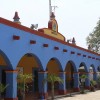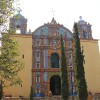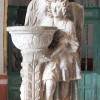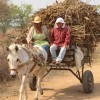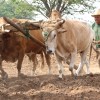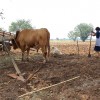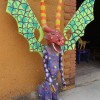Alebrijes Visitors to Oaxaca will find hundreds of fantastically imagined and brightly painted wooden figures for sale in art shops and markets. The carving of alebrijes is a cottage industry here, and supports many families (and not a few towns). Alebrijes originated in Mexico City in 1936, the creation of Pedro Linares, who dreamed of such weird creatures while hallucinating during a serious illness. Previously he had specialized in making papier mâché piñatas for fiestas, so had the trade experience to fabricate the wild denizens of his fevered imagination. His work caught the eye of the painters Diego Rivera and Frida Kahlo and important gallery owners, who commissioned works from him. In the 1980’s the British filmmaker Judith Bronowski arranged an itinerant workshop in the U.S. featuring Linares, as well as the wood carver Manuel Jiménez and the textile artist Maria Sabina, both from Oaxaca. Jiménez expanded on the alebrije art form when he returned to his home in Arrazola, a small village on the outskirts of Oaxaca city. When his hand-made creatures proved to be a hit, other carvers took up the line. In time, the most successful artists flourished in San Martín Tilcajete, another village not many miles from Oaxaca in the Zimatalan valley. There Isidro Cruz shared his skills with others, and eventually several families devoted themselves to the craft. Typically, men do the carving, while women and children sand and paint the figures. Today the industry is an important part of the local economy. The wood favored for alebrijes is that of the copal tree, which is easy to carve and grows in weird shapes that lend themselves to the fabrication of exotic creatures. Unfortunately, there are few such trees remaining around Oaxaca, so the wood must be imported from elsewhere. If you would like more information, go to http://en.wikipedia.org/wiki/Alebrije.
Rodolfo Morales The renowned painter, Rodolfo Morales, hailed from Ocotlan de Morelos and used his wealth and influence for the betterment of that community. Mr. Morelos restored and decorated a number of churches in the area, including the one in Santa Ana Zegache, which we will visit on this hike. Free tours are available of Mr. Morales’ home and studio in Ocotlan, and many examples of his work are on display at the museum in the monastery complex he restored in downtown Ocotlan. (See “Zegache to Ocotlan” hike entry, immediately above.)
Subsistence farming in Zegache For insight into subsistence farming and the need to keep native varieties of corn from becoming extinct, you might want to read an interesting article from the “New York Times”: http://www.nytimes.com/2016/02/12/world/americas/oaxacas-native-maize-embraced-by-top-chefs-in-us-and-europe.html?emc=eta1&_r=0
Time frame: 8:00 depart Oaxaca / 9:00 arrive Zegache – visit church / 9:45 begin overland hike / 11:30 arrive Tilcajete – visit local alebrije workshops / 12:00 leave Tilcajete / 12:15 lunch at Azucena Zapoteca or Tierra Magica restaurant / 1:30 leave restaurant / 2:30 return to Oaxaca.

